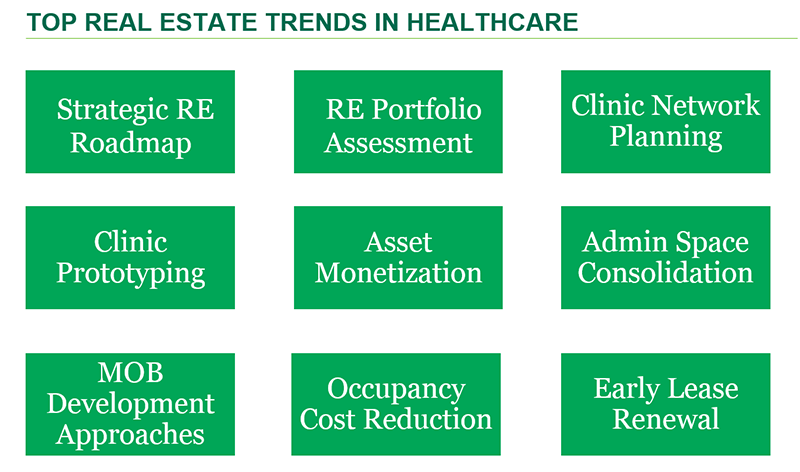

Does Your Organization Have a Strategic Real Estate Roadmap in Place?
By Paul Carr, CCIM/MBA
First Vice President, CBRE
By Dang Nguyen
First Vice President, CBRE
Original Publish Date: November 08, 2016
In meetings with healthcare executives, a common question frequently comes up in conversation – “What are the latest real estate trends in the industry?” The answers revolve around consolidation, strategic partnership and cost compression, among other things. Mergers and acquisitions regularly dominate healthcare industry news, due to the ripple effect such activities create (case in point: the recent announcement of the CHI Franciscan/Virginia Mason alignment).
Unless you are directly involved in the merger, though, these issues, while important, are external to a healthcare organization. The bigger questions real estate professionals often face revolve around internal issues that challenge client organizations. From our standpoint, there are nine major activities that have received a much sharper focus in recent years.

Volumes could easily be written about each of these trends, and depending on the size of the system, healthcare real estate executives may only have to deal with a few of these activities. However, all of these revolve around a common theme; a stronger focus on what we consider one of the most important, if not the most important, activity. That critical but often ignored activity is the process of charting out the Strategic Real Estate Roadmap for the organization.
Putting together such a roadmap is a major undertaking for any organization, as the tremendous efforts required often seem staggering compared to the perceived benefits extracted from such a document. But like any planning document—Business plan, Project charter, Implementation plan, etc.—the activities of collecting data, crunching numbers, brainstorming and integrating ideas often lead to some real benefits for both the short term and the long term. Based on our experience, there are three primary, positive impacts that a strategic real estate roadmap helps to spread across the organization: better internal alignment, good-to-great budgeting and more effective resource planning.
- Internal Alignment. The Roadmap discussion does a wonderful job of forcing conversations that should be happening among departments (e.g. should the carpet in a clinic be replaced eighteen months from the lease expiration date?), brings to the table difficult issues that often lie underneath the surface, and serves as an advanced alert system for activities that may come up in the pipeline (e.g. we will likely renew the lease for another 5 years, so let’s strategize how we can negotiate some TI Allowance from the landlord). These conversations may be happening with or without the work of a real estate roadmap, but by establishing an annual rhythm of refreshing this plan, organizations do see a higher level of rigor, proactivity and transparency in real estate-related conversations which can help avoid costly mistakes or oversights.
- Good-to-Great Budgeting. As with internal alignment, rigor and transparency are two keys to good budgeting. Forcing difficult, proactive conversations can help healthcare organizations anticipate capital needs and prioritize capital requests, all while formalizing a multi-year capital plan. Since real estate projects typically take up a major line item in the budget, having a solid real estate roadmap in place leads to a more thoughtful capital plan. Having been intimately involved in our clients’ budgeting process over the years, our observation is that while the process of building a real estate roadmap rationalizes the real estate needs, the capital budgeting process helps prioritize the real estate needs.
- Effective Resource Planning. Once there is a real estate roadmap in place supported by a comprehensive capital plan, executing the plan still requires the diligent focus and efforts by various teams (clinical, facilities, IT). By the time these teams start executing, none of these initiatives and discussions will be new to them; the process of building/refreshing the real estate roadmap, and the subsequent capital budgeting effort, already familiarize the key players and get everyone on the same page. At execution time, internal alignment will be what helps avoid the common mistake, often made by large organizations, of the right hand not talking to the left hand. A strategic real estate roadmap flows through both the capital budget and operating budget process, helping to ensure accuracy, consistency and connectedness among the various touch points within the organization.
Real estate is an industry where there are plenty of stories about deals being made over drinks and deal terms being worked out on the back of a napkin, and there is often a grain of truth to some of these tales. Nevertheless, as professionals who have been through many annual business planning and budgeting cycles with our client organizations, we can safely proffer that those organizations which seem to make rapid-fire decisions and tend to grab the best market opportunities focus on planning a great deal. Real estate executives of these successful healthcare organizations are closely tuned into the overall direction of the business and market as a whole. They are rigorous in their real estate planning rhythms and demand a disciplined approach to execute an approved real estate plan. The apparent effortlessness with which these organizations make their decisions is a result of the attention they pay to their planning processes. Having a sophisticated strategic real estate roadmap is a constant among these organizations and professionals, and a necessary tool to ensuring that regardless of uncertainty in the terrain, their real estate decisions remain aligned on the right path.
Paul Carr has assisted with the leasing requirements for some of Seattle’s largest multi-specialty physician groups, the monetization of medical office buildings and excess land for a variety of regional and community hospital systems and the acquisition of medical office buildings for investors and physician groups alike. He has been with CBRE since 2001 and consistently ranks among the top CBRE Brokers in Washington State. He can be reached at paul.carr@cbre.com or 206-292-6005.
Dang Nguyen has been with CBRE since 2000, supporting major clients including Group Health Cooperative, MultiCare Health System, Microsoft Corporation and the former Washington Mutual Bank in the capacity of embedded real estate consultant. For three years until the end of 2015, he led a 43-person team on the MultiCare Health System account delivering all facets of services from real estate strategy and planning to transaction and capital project execution. Nguyen brings the insights and experience of strategic consulting and transaction advisory for corporate decision makers. He can be reached at dang.nguyen@cbre.com or 206-292-6026.
About CBRE Group, Inc.
CBRE Group, Inc. (NYSE:CBG), a Fortune 500 and S&P 500 company headquartered in Los Angeles, is the world’s largest commercial real estate services and investment firm (based on 2015 revenue). The Company has more than 70,000 employees (excluding affiliates), and serves real estate investors and occupiers through more than 400 offices (excluding affiliates) worldwide. CBRE offers a broad range of integrated services, including facilities, transaction and project management; property management; investment management; appraisal and valuation; property leasing; strategic consulting; property sales; mortgage services and development services. Please visit our website at www.cbre.com.